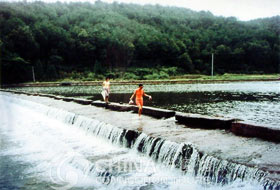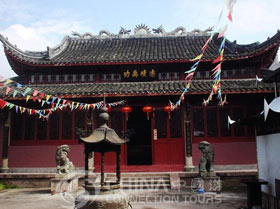 Tashan Weir, located by Mount Tashan southwest of Yinjiang Town, Yin County, was built by Wang Yuanwei, Administrator of Yin County, in the year 833. It was built in the upstream of the Brook Zhangxi (formerly named Daxi), is one of the four major water conservancy projects in ancient China (the other three being Zhengguo Aqueduct, Ling Aqueduct and Dujiang Weir). To the south of the Brook Zhangxi were rolling mountains, and to the north a vast plain. Standing near the southern bank of the brook was a solitary hill named Mount Tashan. Tashan Weir, 134.4 meters high and 4.8 meters wide, was built up with eighty and a half pieces of stone slabs measuring 2 to 3 meters long and 0.2 to 0.35 meters wide. Thirty-six stone steps were provided on both the left and right. The surface of the Weir is built with stone and the body of the weir is built with both stone and wood. It's also the major cultural relic under the protection of the state. Legend has it that there was a huge trunk of plum-wood lying in the Weir, firm as ever through over one thousand years, hence the name 'the Plum Beam of Tashan Weir."
Tashan Weir, located by Mount Tashan southwest of Yinjiang Town, Yin County, was built by Wang Yuanwei, Administrator of Yin County, in the year 833. It was built in the upstream of the Brook Zhangxi (formerly named Daxi), is one of the four major water conservancy projects in ancient China (the other three being Zhengguo Aqueduct, Ling Aqueduct and Dujiang Weir). To the south of the Brook Zhangxi were rolling mountains, and to the north a vast plain. Standing near the southern bank of the brook was a solitary hill named Mount Tashan. Tashan Weir, 134.4 meters high and 4.8 meters wide, was built up with eighty and a half pieces of stone slabs measuring 2 to 3 meters long and 0.2 to 0.35 meters wide. Thirty-six stone steps were provided on both the left and right. The surface of the Weir is built with stone and the body of the weir is built with both stone and wood. It's also the major cultural relic under the protection of the state. Legend has it that there was a huge trunk of plum-wood lying in the Weir, firm as ever through over one thousand years, hence the name 'the Plum Beam of Tashan Weir."
Although Tashan Weir has weathered storms of hundreds of years and witnessed the vicissitudes of the world, the Weir still played a major role in blocking seawater and conserving freshwater. Intercepted by the Yin River, the Weir diverted the water from upstream of the Brook Zhangxi: one stream flew towards the Nantang River, passed through Dongqiao, Hengzhang, Beidu, Lishe, Shiqi and Duantang, and then through the water gate in the south of Ningbo City before emptying into the Sun Lake (no longer existent now) and the Moon Lake, from where freshwater was supplied via branch canals to the City; the other stream flew northwards, and passed through Xiaoxi, Meiyuan and Shenjiao. The two streams, with diversions by branch distribution networks, transverse the towns in Yinxi Plain, and irrigated thousands of hectares of farmland in 7 towns (benefiting 16,000 hectares of farm land even today). The Weir was of a deliberate design, ingenious structure and sophisticated workmanship. In time of flood, 70% of the water was discharged through the River, with the remaining 30% led to the Brook; in time of drought, 70% of the water was led to the Brook, with the remaining 30% led to the River. To control the water levels, three water gates, namely Wujin, Jidu and Xingchun, were built between the inner and the outer rivers and in the downstream of Nantang River.
 Tashan Weir became more and more complete through repairs, dredging and addition of auxiliary works of Song, Yuan, Ming, Qing Dynasties and at the time of the Republic of China. Some 50 miles northwest of Tashan Weir lies the Huisha Floodgate built by Magistrate Chen Kai in 1242(the 2nd year of Chunyou reign in Song Dynasty). The purpose of the floodgate was to prevent the river from being blocked by quicksand. As auxiliary projects, Hongshuiwan Dyke was built by Wu Qian, an official in 1255 (During Baoyou reign in South Dynasty) and Guanchi Dyke was, later on, constructed in 1524 (The 3rd Year of Jiajing Period in Ming Dynasty). These dykes could not only discharge flood, but stop sand from entering the river.
Tashan Weir became more and more complete through repairs, dredging and addition of auxiliary works of Song, Yuan, Ming, Qing Dynasties and at the time of the Republic of China. Some 50 miles northwest of Tashan Weir lies the Huisha Floodgate built by Magistrate Chen Kai in 1242(the 2nd year of Chunyou reign in Song Dynasty). The purpose of the floodgate was to prevent the river from being blocked by quicksand. As auxiliary projects, Hongshuiwan Dyke was built by Wu Qian, an official in 1255 (During Baoyou reign in South Dynasty) and Guanchi Dyke was, later on, constructed in 1524 (The 3rd Year of Jiajing Period in Ming Dynasty). These dykes could not only discharge flood, but stop sand from entering the river.

